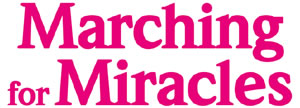Marching for Miracles
The March of Dimes Walk helps make miracles possible for keiki like the daughter of Bob Ingersoll. In the United States one of every eight babies is born prematurely and, unfortunately for Longs vice president/general manager of Hawaii operations Bob Ingersoll, he and his wife drew the short straw when their daughter Ashley was born eight weeks premature in 1989.
By Chad Pata
E-mail this story | Print this page | Archive | RSS |
 Del.icio.us
Del.icio.us
In the United States one of every eight babies is born prematurely and, unfortunately for Longs vice president/general manager of Hawaii operations Bob Ingersoll, he and his wife drew the short straw when their daughter Ashley was born eight weeks premature in 1989.
Fortunately for the Ingersolls, March of Dimes was there.
“I didn’t really know where the equipment and technology came from, I was just glad it was there,” says Ingersoll. “I didn’t really understand until the last few years that it was the March of Dimes supporting this and setting up the neonatal intensive care at these hospitals. I was talking with my neighbor about the March of Dimes and finding out about what they did, I was like, heck, we were direct beneficiaries of this 20 years ago. So it was an easy thing for me to get behind.”
Today Ashley is a healthy sophomore at Willamette University in Oregon, where she is studying music. And because of her safe journey through the rigors of a premature birth, her father is now the chairman of the March for Babies, Saturday’s fundraiser for the March of Dimes that used to be known as WalkAmerica.
The charity walk was invented by the March of Dimes in 1970 and has raised close to $2 billion for research in its lifetime, though the walk today bears little resemblance to the original, according to March of Dimes state director Carmella Hernandez.
The original walk was 22 miles, and they would accept pledges for each mile completed by its participants. It was an arduous task that only the most fit would take on.
They have since come to their senses.
“The great thing about the walk is you don’t even have to walk it!” says Hernandez of the new four-mile loop from Kapiolani Bandstand to Ala Moana Park and back. “You can just walk a block and come back. We want to make it enjoyable for the whole family.”
The pledges are now based on participation only, and all proceeds go to aid the March of Dimes’ work in preventing birth defects, premature births and infant mortality.
For those unfamiliar with the March of Dimes, it was created by President Franklin D. Roosevelt to defeat polio in 1938, a disease that FDR was stricken with himself. Originally known as the National Foundation for Infantile Paralysis, they held an annual fundraiser known as the March of Dimes, a play on words of the popular newsreels at the time “The March of Time.”

|
They contended that if everyone in America gave just a dime they could beat the disease, and though FDR did not live long enough to see it through to its fruition, it is one of the reasons you will find his head on the dimes in your pocket today.
Through its funding, Jonas Salk and Albert Sabin made breakthroughs with a polio vaccine that wiped out the disease, and caused the charity in 1958 to reassess its focus to its current concern with prenatal care.
In Hawaii alone there are 44 babies each week born prematurely, a number that has increased by 13 percent over the past 10 years. They are trying to combat these increases by assuring that all moms get adequate care during their pregnancy. Currently only 65 percent of moms are getting the care they need during the pregnancy, a number March of Dimes hopes to have at 90 percent by 2010.

|
Beyond the ultimate goal of having every baby born healthy, there also is the cost factor associated with premature births, which they estimate at $26.2 billion a year in societal economic costs from medical, educational and lost productivity.
But all that money means nothing when you are dealing with a premature child of your own.
Local architect Chrysti Lu’s son Camren was born 15 weeks early in January 2006. Suddenly her life was being lived in the Neonatal ICU, surrounded by medical staff caring capably for her second son, but none of them talking in a way that could comfort Lu.
This is where the March of Dimes stepped in. Not only is it doing the research to try to help prevent future premature births, but its volunteers are there to comfort the moms going through it today.
“The volunteers from MOD were so helpful. (The volunteer) being a mother who had gone through premature births multiple times really helped ease our fears,” says Lu. “You are surrounded by doctors and nurses; having a mom who could talk to me without using such big words was so important to me.”
Tragically Lu’s son passed away after 13 months, but the MOD made such an impression on Lu that she has volunteered with them to help
Page 1 of 2 pages for this story 1 2 >
E-mail this story | Print this page | Comments (0) | Archive | RSS
Most Recent Comment(s):








